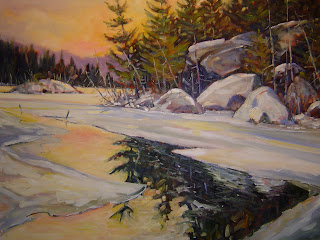


I have discussed my palette, kit and set up procedures in the previous two posts, so this post will cover how I approach and carry out a painting project. I paint on numerous surface materials ranging from canvas duck, linen to solid surfaces to include masonite, MDF board and birch panel. I work on a range of differently sized formats to include 5x7"... 8x10"... 10x12"...11x14"... 12x16"... 14x18"...16x20"...20x24"... 24x30"... 30x36"... 36x48"... 48x60" and on occasion triptychs which are composed of a combination of three of these other formats.
I work outdoors mainly on 5x7"...10x12"...16x20"..20x24 inch and 30x36" formats. I do not feel at all uncomfortable with larger sized pieces on location...provided that weather conditions are favourable... that the subject deserves a larger format and that it excites my interest. I lay in with a single larger flat brush...one inch variety usually....working the whole area of the canvas randomly... until the entire canvas surface is covered.If I am employing a "colour massing" approach...I squint at the subject through my eyelids and apply a broad area of colour using large strokes which are close to the value I "see". However, I do not push to find the most accurate value... that comes later in the session after the entire canvas is covered. I work quickly...trying to find "the Flow" as I will refer to it... a state reached where you are working intuitively... searching... seeking out patterns...and creating gestural passages as opposed to details.At the end of this "fleshing out" focus...I step back, or even go for a short walk to get away from the "path" I am thinking about. When I return to the project... I feel refreshed and start looking for new areas to focus on... to add "specifics"... which include stronger areas of colour... vertical and diagonal lines... value corrections... anything that might contribute a stronger statement. This is especially true in focusing on the main subject in the painting... where the darkest darks and lightest lights should converge to create the highest visual interest for the viewer.
When I am satisfied that I have successfully absorbed and arranged the essence of my subject, I can choose to end the session at this point and use my digital camera to record a useful reference photo to "fine tune" the piece to an ending in the studio...away from the actual subject. Or if time (and my energy level) permits... I can push forward to completion right on location. Both situations do occur frequently and do produce equally good results. Often, I will pull out an 8x10" or 5x7" panel and quickly attack a nearby subject I might have noticed during the session...or on my "stroll" at the mid point. I never worry about creating a "masterpiece" with this effort... I treat it as...my "run-for-the-sun"....stealing time at the end of the day... an opportunity to take home yet another "Idea"...which can be developed further in the studio...or even be returned to at a later date...a "memo" to my Self.
This is but one strategy or appraoach that I employ to work successfully in the field. I regularly use other approaches and create what I call "mental gymnastics"... to refresh my enthusiasm and to avoid systematic and predictable conclusions...all dead ends in the creative process. No learning can occur...when the end is predictable...or defined. I will describe some of these "alternate routes" I regularly include in my own painting journey... in upcoming posts. Stay tuned!
Until then.... Good painting... to ALL!
No comments:
Post a Comment